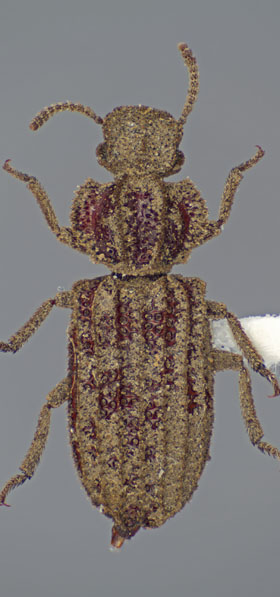 |
 Previous Genus Next Genus Previous Genus Next Genus 
Genus: Rhagodera
Diagnostic Features
- Description: Antennae 11-segmented with an indistinct, 3-segmented club. Antennal setation dense, scaly. Subantennal grooves/depressions present or absent. Eyes small, coarsely faceted, with scale-like interfacetal setae. Pronotal disc with a pair of costae. Lateral margin of pronotum serrate, appearing curved or sinuate when teeth are filled with debris. Procoxal cavities narrowly open. Metacoxae narrowly separated, separation less than metacoxal length. Elytra fused. Each elytron with 3 costae. Tarsal formula 4-4-4. Body usually encrusted with sand, dirt, or debris.
- Similar genera: The genus Rhagodera is superficially similar to the genus Pseudocorticus. The lack of elytral carinae and 1-segmented antennal club serve to distinguish Pseudocorticus.
Known Distribution
- Southwestern United States (CA, AZ, TX), Mexico.
Probable Distribution
- Southwestern United States (NM).
Biology
- Members of this genus are flightless and ground-dwelling. They inhabit arid, deserted regions. The larvae are unknown. Little is known about the biology of this group.
- Abundance: Rarely encountered.
North American Species (4)
Species Diagnoses
- Rhagodera tuberculata: Subantennal groove/depression present. Antennal segment 3 not greatly elongate. No elytral costae join near apex. Second elytral costa not interrupted before apex. Epipleural fold does not reach apex of elytra. Distribution: California and Arizona, USA.
- Rhagodera interrupta: Subantennal groove/depression absent. Antennal segment 3 greatly elongate. No elytral costae join near apex. Second elytral costa interrupted before apex. Epipleural fold does not reach apex of elytra. Distribution: California, USA.
- Rhagodera costata: Subantennal groove/depression present. Antennal segment 3 not greatly elongate. Lateral margin of pronotum appearing sinuate when filled with debris. Elytral costae 1 and 2 joined near apex. Epipleural fold reaches apex of elytra. Distribution: Southern Arizona, USA.
- Rhagodera texana: Subantennal groove/depression present. Antennal segment 3 not greatly elongate. Lateral margin of pronotum appearing evenly curved when filled with debris. Elytral costae 1 and 2 joined near apex. Epipleural fold reaches apex of elytra. Distribution: Texas, USA.
Discussion
- Members of this genus are quite distinct from all other members of the subfamily Colydiinae, with a number of characters separating it as a distinct group. The specific placement of this genus in the overall classification of the family is uncertain.
Potential Problems with Identification
- Members of this genus are frequently encrusted with sand and other debris, which may conceal the pronotal and elytral characters. Rhagodera costata and Rhagodera texana are very similar. Although unsatisfactory, their distribution serves as the best diagnosis.
Selected References
|
 |
 
Rhagodera costata
© N.P. Lord |
© 2011-2015 Lord, N.P., Nearns, E.H., and K.B. Miller
The University of New Mexico and Center for Plant Health Science and Technology, USDA, APHIS, PPQ.
|


